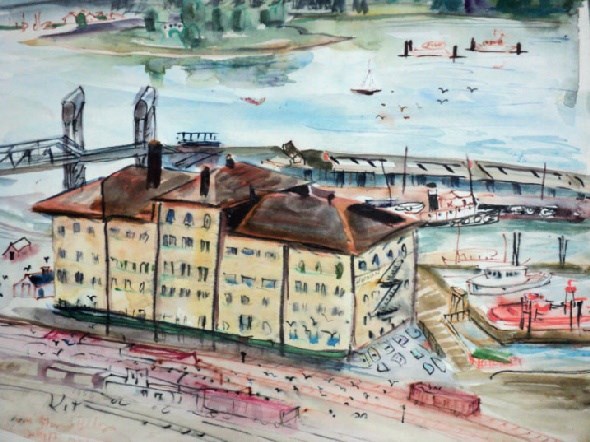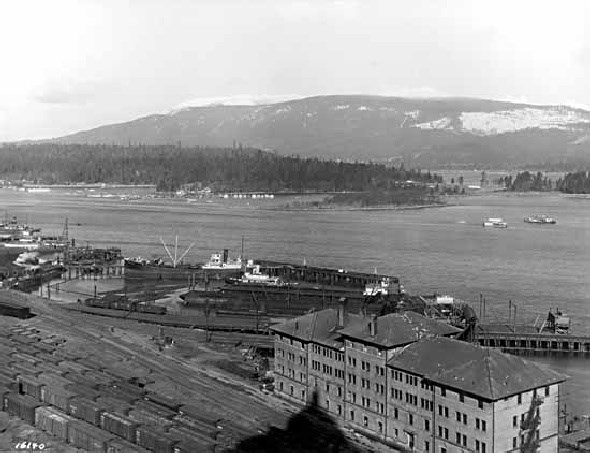 Painting by Gordon Kit Thorne, CPE, CSPE, FCA
Painting by Gordon Kit Thorne, CPE, CSPE, FCA
Towards Stanley Park, a title I've given this watercolour painting by Gordon Kit Thorne, CPE, CSPE, FCA. It was Tom Carter who pointed out to me the building in the foreground is Vancouver's former Customs and Immigration building, previously located where the Convention Centre is now. The painting appears to say "From the Marine Building" in Gordon's handwriting in the bottom left, along with the date July 13, 1957, and, ehr, 1956 too (it's got to be one of those two dates!). If you compare the view from the VPL photo 6193 also shown here, you can actually see the shadow of the Marine Building!
 VPL photograph 6193 by Leonard Frank, 1933
VPL photograph 6193 by Leonard Frank, 1933
This painting sold on eBay a year ago for $37 and I had always meant to give this painting its due coverage. Looking further into Coal Harbour and you can see the Esso floating barge gas station, and to the right you can just make out a second gas station as well. This may be a bit of a diversion, but I started to wonder about all the marine gas stations that have appeared just off the shores of Stanley Park. Excluding any gas stations on land attached to a marina like , how many can you name?
I shall try to compile a most comprehensive summary of the floating barge gas stations of Coal Harbour, from present day all the way back to the beginning. Kicking things off, Robert Allan Naval Architects begin with in Coal Harbour which was put in place in January 2010. From their website:
This station replaced the venerable Chevron barge S.O.B.C. No. 5 which has been moored in Coal Harbour since it was built in 1959. Both the original fuel barge and the modern replacement were designed by Robert Allan Ltd., Naval Architects of Vancouver, B.C. The project leaders at Robert Allan Ltd. for this vessel were Bart Stockdill, P. Eng., Project Manager, and Allan Turner, P. Eng., Project Engineer.
On his blog, Nelson Quiroga in gasoline alley. he shows a photo of both the Chevron & Esso fuel barges. Shell was the third company he mentions, but that's when things get a bit fuzzy for me.
in the water in the 1990s, and Gulf in the 1980s. You can actually see this Gulf gas station, along with the Esso station in , where Bill Reiter attempts to interview a yacht from the shores of Coal Harbour. This next photographic record is a fabulous showcase of Esso, Home Gas, Standard Oil, and Shell seen in the summer of 1972. This was just before the OPEC fuel crisis, so you can be sure gas was a whole lot cheaper then!
Standard Oil () would eventually be rebranded as Chevron; Standard is most likely the second gas station shown in the painting above. Standard Oil of British Columbia was established in 1935, an expansion of Standard Oil of California (Socal). The Â鶹´«Ã½Ó³»city archives has a blueprint of dated March 12, 1936, so it looks like they didn't waste much time before getting into the marine gas business.
Home Gas was an early Â鶹´«Ã½Ó³»fixture, with gas stations both in the water and on land. Here's . Home Gas sponsored the Home Gas Sunday Symphony Hour at Malkin Memorial Bowl in Stanley Park before WWII, . Â鶹´«Ã½Ó³»Home Gas was also the name of a local lacrosse team way back in 1937, although it seems they wound up merging with the Richmond Farmers .
At some point in time in the 1950s, Texaco was also seen in Coal Harbour, as shown in this . Shell, Esso, and Standard Oil can apparently be seen together ; Shell and Standard Oil appear . And the earliest photograph that I could find showing a marine gas station is this showing one lonely station in the middle of Coal Harbour. Also highly visible are the C.P.R. fuel tanks near the foot of Cardero Street, which can also be seen in . Thankfully, those are no longer in the way!
And that rounds out my exploration of the gas stations of Coal Harbour. Please if I've omitted anything!
Update! Additional comments from and cafeyvr discuss the devastating explosion of the Home Gas barge in 1974, and here cafeyvr writes about the number of barges in Coal Harbour:
The largest count I saw was six from a Sunday Sun article in 1959 (one of them was dockside). Another newspaper article from 1952 listed five of them in Coal Harbour.There were five of them from a Â鶹´«Ã½Ó³»Sun report in of when Home’s barge was destroyed in a fire: Home, Esso, Standard, Shell, Texaco. It also said the Home barge was the oldest at the time at almost 30 years old.
Then eventually one barge had the two Esso/Home Gas signs. Imperial bought Home Gas and operated the brand for a while…
, photos show the harbour at night in the 1960s, depicting Imperial, Home, and Esso illuminated in glowing neon. And finally, presents the PetroCanada in between Esso and Shell.
One legendary tale I forgot to mention; there was a time in the 1960s when a prankster loaded the barrel of the 9 o’clock gun with rocks; when the gun went off, the projectiles went right through the Esso sign. Though I don’t know who loaded the gun, but I believe the story to be true. I’ve heard an account of this from someone who was here when it happened; mentions the event as well, though a citation is required. If anyone has any more details, the Internet remains interested as ever!


